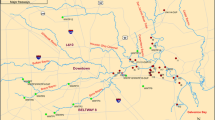Abstract
A municipal sewer system has been investigated for the sources of a set of semivolatile compounds, such as polychlorinated dibenzo-p-dioxins (PCDD), polychlorinated dibenzofurans (PCDF), polychlorinated biphenyls (PCB), hexachlorobenzene (HCB), 1,1-dichloro-2,2-bis(p-chlorophenyl)-ethene (4,4'-DDE), and chlorinated paraffins (CP), using sewer films as the sampling medium. A cleanup method for these semivolatile compounds in sewer films is described. The project has been undertaken for the differentiation and localization of specific inputs of xenobiotics from defined regions of the city. A unique pattern of PCDD/PCDF found in sewage sludge has led to the search for a specific source within the sewer system, which has finally been localized as a distinct plant. Other organochlorine compounds proved to be significant indicators for industrial and domestic sewers. PCB appeared as an industry correlated parameter, while 4,4'-DDE indicated domestic sewers. Chlorinated paraffins have been detected in the mg/kg range and are markers and indicators for metal-working industries. Finally, the release of CP by the sewage treatment plant, into the nearby river, has been investigated.
Similar content being viewed by others
References
Drescher-Kaden U, Brüggemann R, Matthies M, Matthes B (1990) Organische Schadstoffe im Klarschlamm. In: Rippen G (ed) Handbuch Umwelt-Chemikalien, Teil II-2.4. Eco Med, Landsberg, pp 1–314
Schönberger H (1990) Klärschlammkontamination auf Raten. Institut für ökologisches Recycling, Berlin
Weißer M, Klute R, Hahn HH (1992) Untersuchungen zur Belastung kommunaler Klärschlämme durch organische Schadstoffe. Bericht BMFT-Vorhaben 02WS464/8, ISWW Karlsruhe
Gutekunst B, Hahn HH (1985) Vom Wasser 65:127–137
Wang M, Jones KC (1991) Chemosphere 23,5:677–691
Walter B (1992) Dissertation, University of Ulm
Gihr R, Klöpffer W, Rippen G, Partscht H, Stoll U (1991) Korrespondenz Abwasser 38:802–805
Klärschlammverordnung (1992) Bundesgesetzblatt Teil 1, pp 912–935
Sachstand Dioxine (1985) Umweltbundesamt Berlin. Schmidt, Berlin
Ballschmiter K (1991) Nachr Chem Tech Lab 39:988–1000
Bacher R, Swerev M, Ballschmiter K (1992) Environ Sci Technol 26:1649–1655
Wiberg K, Lundström K, Glas B, Rappe C (1990) Chemosphere 19:735–740
Buser H, Bosshardt H (1978) Mitt Geb Lebensm Hyg 69:191–199
Ballschmiter K, Buchert H, Niemczyk R, Munder A, Swerev M (1986) Chemosphere 15:901–915; Ballschmiter K, Bacher R, Riehle U, Swerev M (1990) BMFT Report Nr. 07 640 040, Bonn; Bacher R, Riehle U, Swerev M, Ballschmiter K (1991) Chemosphere 23:1151–1171
Tysklind M, Söderström G, Rappe C (1989) Chemosphere 19:705–710
Öberg T, Allhammar G (1989) Chemosphere 19:711–716
Lamparski L, Nestrick T (1983) Chemosphere 12:617–626
Swerev M, Ballschmiter K (1989) Chemosphere 18:609–616
Bottimore D, Barnes D, Kutz F, Bretthauer E, Greim H (1990) Toxicol Environ Chem 26:99–109
Safe S (1990) C.R.C. Crit Rev Toxicol 21:51–88
Gerhartz W (1986) Ullmann's Encyclopedia of Industrial Chemistry, 5th edn, vol A6. Verlag Chemic, Weinheim New York, pp 323–330
Beratergremium für umweltrelevante Altstoffe der Gesellschaft Deutscher Chemiker (1992) BUA-Stoffbericht Nr. 93: Chlorparaffine. Hirzel, Stuttgart
Willis B, Crookes M, Diment J, Dobson S (1994) Environmental hazard assessment: chlorinated paraffins. Directorate for Air, Climate and Toxic Substances, Department of the Environment Garston, Watford WD2 7JR, ISBN 0 85125 627 9
Schmid P, Müller M (1985) J Assoc Off Anal Chem 68:427–430
Champbell I, McConnell G (1980) Environ Sci Technol 14:1209–1214
Jansson B, Andersson R, Asplund L, Litzen K, Nylund K, Sellström U, Uvemo U, Wahlberg C, Widequvist U, Odsjö T, Olsson M (1993) Environ Toxicol Chem 12:1163–1174
Serrone D, Birtley R, Weigand W, Millischer R (1987) Fd Che Toxic 25:553–562
Birtley R, Conning D, Daniel J, Ferguson D, Longstaff E, Swan A (1980) Toxicol Appl Pharmacol 54:514–525
US Department of Health and Human Services, Public Health Service, National Institute of Health (1986) National Toxicology Programm, Techn Rep 308:1–67
Hagenmaier H, Brunner H, Knapp W, Weberruss U (1986) Umweltbundesamt Berlin, Forschungsbericht 103 03 305. Hagenmaier H, Brunner H, Haag R, Berchtold A (1986) Chemosphere 15:1421–1428
Butzkammer-Erker R, Mach R (1990) Korrespondenz Abwasser 37:161–163
Hagenmeier H, Brunner H, Haag R, Berchtold A (1986) Chemosphere 15:1421–1428
Swerev M. Ballschmiter K (1986) GDCh Informationstag 86/496, Frankfurt/Main
Ehmann J (1985) Diploma Thesis, University of Ulm
Rieger R (1991) Diploma Thesis, University of Ulm
Schimmel H, Riehle U, Reuter U, Ballschmiter K (1992) Chemosphere 24:413–420
Schimmel H, Schmid B, Bacher R, Ballschmiter K (1993) Anal Chem 65:640–644
Bacher R, Ballschmiter K (1992) Chromatographia 34:137–142
Ballschmiter K, Zell M (1980) Fresenius Z Anal Chem 302:20–31
Ballschmiter K, Mennel A, Buyten J (1993) Fresenius J Anal Chem 346:396–402
Kovats (1958) Helv Chim Acta 41:1915
Walter B, Ballschmiter K (1991) Fresenius J Anal Chem 340:246–249
Jansson B, Andersson R, Asplund L, Bergmann Å, Litzen K, Nylund K, Reutergårdh L, Sellström U, Uvemo U, Wahlberg C, Widequvist U (1991) Fresenius J Anal Chem 340:439–445
Müller M, Schmid P (1984) HRC & CC 7:33–37
Eitzer B, Hites R (1989) Environ Sci Technol 23:1396–1401
Rieger R, Ballschmiter K (1992) Poster presented at 12th International Symposium on Dioxins and Related Compounds, 24–28. August, Tampere, Finland
Wittlinger R, Ballschmiter K (1987) Chemosphere 16:2497–2513
Schreitmüller J, Vigneron M, Bacher R, Ballschmiter K (1994) Int J Environ Anal Chem 57:33–52
Cash GC, Breen JJ (1992) Chemosphere 11:1607–1623
Ballschmiter K, Niemcyk R, Schäfer W, Zoller W (1987) Fresenius Z Anal Chem 328:583–587
Zitomer D, Speece R (1993) Environ Sci Technol 27:226–244
Author information
Authors and Affiliations
Additional information
Dedicated to Professor Dr. Dr. h.c. mult. J. F. K. Huber on the occasion of his 70th birthday
Rights and permissions
About this article
Cite this article
Rieger, R., Ballschmiter, K. Semivolatile organic compounds — polychlorinated dibenzo-p-dioxins (PCDD), dibenzofurans (PCDF), biphenyls (PCB), hexachlorobenzene (HCB), 4,4'-DDE and chlorinated paraffins (CP) — as markers in sewer films. Fresenius J Anal Chem 352, 715–724 (1995). https://doi.org/10.1007/BF00323054
Received:
Revised:
Accepted:
Issue Date:
DOI: https://doi.org/10.1007/BF00323054




